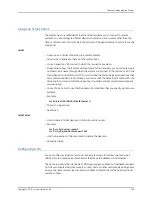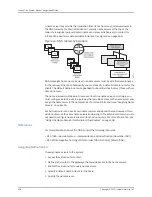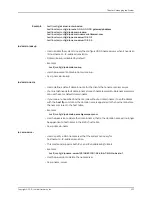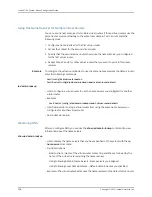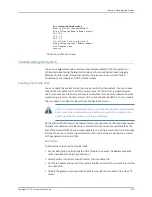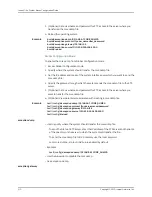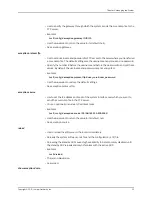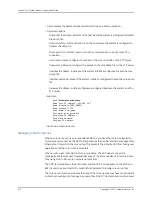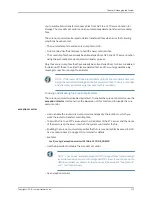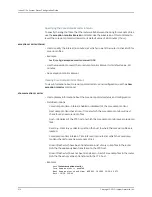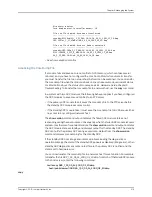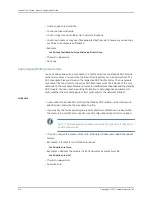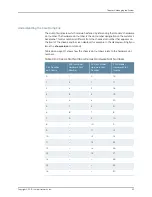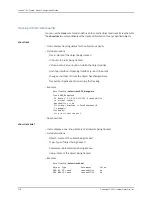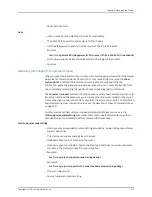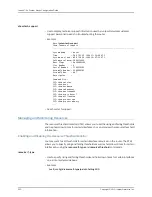
Using the Telnet Client
The system has an embedded Telnet client that enables you to connect to remote
systems. You can configure a Telnet daemon to listen in virtual routers other than the
default virtual router. You must be in the context of the desired virtual router to issue the
command.
telnet
•
Use to open a Telnet connection to a remote system.
•
Specify the IP address or name of the remote host.
•
You can specify a VRF context in which the request takes place.
•
Depending on how the remote system accepts Telnet requests, you can specify a port
number or port name through which the system will connect to the remote host. In the
Transmission Control Protocol (TCP), ports define the ends of logical connections that
carry communications. In most cases, you can accept the default, port number 23, the
Telnet port. For more information about port numbers and associated processes, see
www.iana.org.
•
You can force Telnet to use the IP address of an interface that you specify as its source
address.
•
Example
host1#
telnet 192.168.35.13 fastEthernet 0
•
There is no
no
version.
•
See telnet.
telnet listen
•
Use to create a Telnet daemon to listen in a virtual router.
•
Example
host1(config)#
virtual-router 3
host1:3(config)#
telnet listen port 3223
•
Use the
no
version of the command to delete the daemon.
•
See telnet listen.
Configuring DNS
You can configure virtual routers to act as
name resolvers
for Domain Name Service
(DNS). DNS is a client/server mechanism that maps IP addresses to hostnames.
The name resolver is the client side of DNS and receives address-to-hostname requests
from its own clients when they want to contact hosts on other networks. By polling
name
servers,
the name resolver learns name-to-address translations for the hosts its clients
want to contact.
305
Copyright © 2010, Juniper Networks, Inc.
Chapter 5: Managing the System
Summary of Contents for JUNOSE 11.3
Page 6: ...Copyright 2010 Juniper Networks Inc vi...
Page 8: ...Copyright 2010 Juniper Networks Inc viii JunosE 11 3 x System Basics Configuration Guide...
Page 24: ...Copyright 2010 Juniper Networks Inc xxiv JunosE 11 3 x System Basics Configuration Guide...
Page 32: ...Copyright 2010 Juniper Networks Inc 2 JunosE 11 3 x System Basics Configuration Guide...
Page 146: ...Copyright 2010 Juniper Networks Inc 116 JunosE 11 3 x System Basics Configuration Guide...
Page 166: ...Copyright 2010 Juniper Networks Inc 136 JunosE 11 3 x System Basics Configuration Guide...
Page 432: ...Copyright 2010 Juniper Networks Inc 402 JunosE 11 3 x System Basics Configuration Guide...
Page 488: ...Copyright 2010 Juniper Networks Inc 458 JunosE 11 3 x System Basics Configuration Guide...
Page 524: ...Copyright 2010 Juniper Networks Inc 494 JunosE 11 3 x System Basics Configuration Guide...
Page 554: ...Copyright 2010 Juniper Networks Inc 524 JunosE 11 3 x System Basics Configuration Guide...
Page 566: ...Copyright 2010 Juniper Networks Inc 536 JunosE 11 3 x System Basics Configuration Guide...
Page 588: ...Copyright 2010 Juniper Networks Inc 558 JunosE 11 3 x System Basics Configuration Guide...
Page 613: ...PART 3 Index Index on page 585 583 Copyright 2010 Juniper Networks Inc...
Page 614: ...Copyright 2010 Juniper Networks Inc 584 JunosE 11 3 x System Basics Configuration Guide...
Page 632: ...Copyright 2010 Juniper Networks Inc 602 JunosE 11 3 x System Basics Configuration Guide...















